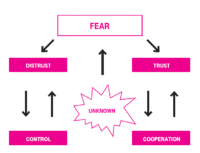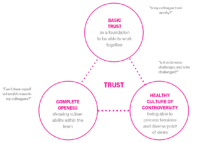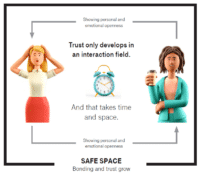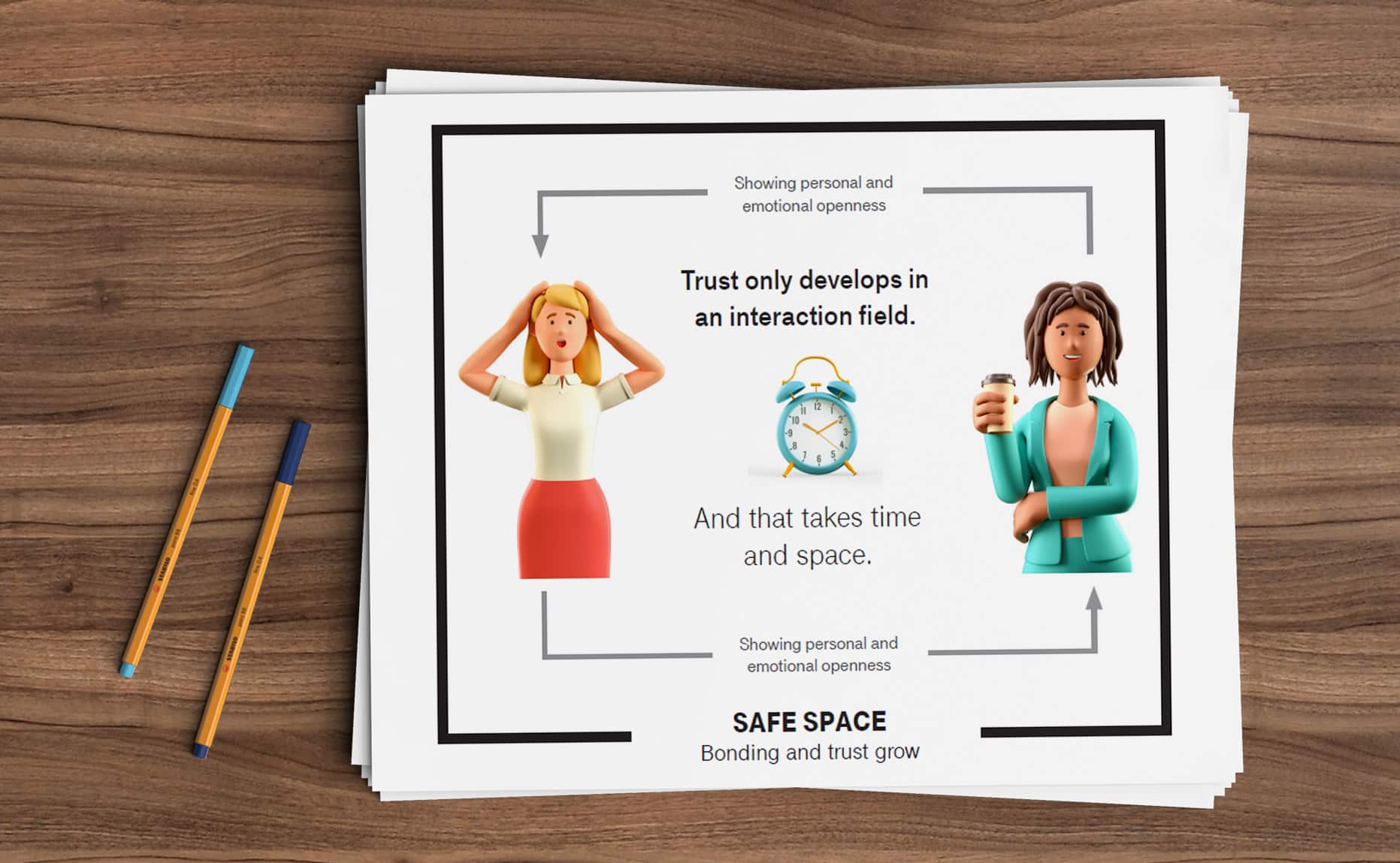CONFIDENCE AND PSYCHOLOGICAL SAFETY – Part 1.
Whether team members feel psychologically safe has a strong impact on the team’s performance, as it forms the basis for innovation, motivation, commitment and creativity.
- Part 1: Trust
- Part 2: Psychological safety
- Part 3: Team performance
Part 1: Trust
What is trust?
Throughout our lives, we have all had experiences of trust and mistrust in one form or another, and this begins in the early days of childhood.
So there is a lot of everyday knowledge about what trust actually means, and it is shaped by our own personal experiences, i.e. experiences in which the trust we have given has been confirmed or not confirmed.
To better understand psychological safety, it is helpful to take a closer look at the concept of trust.
Trust is a question of behavioral safety.
When you have trust, you expect others to behave in a certain way.
This expectation is learned over time, either through experience of a person’s behavior in previous interactions or independently of the person through substitutes (e.g. trust in professions, institutions, departmental origins).
From a social science perspective, trust makes our lives easier by reducing social complexity.
By trusting, we anticipate the future.
We place expectations on our counterpart – which can also be ourselves – as to how the person should behave in the future.
We have a lot of social relationships.
Trust enables us not to have to check our behavior in every relationship and situation.
We assume that, based on our experience, the probability of a behavior occurring is very high.
Like control, trust is a form of risk reduction.
Trust makes our lives easier! It is an effective form of reducing social complexity.(Luhmann, 1989)
When we are confronted with the unknown – which is increasingly the case in a dynamic environment – we initially react with uncertainty or fear.
In such a situation, we can either trust or distrust.
In the case of mistrust, we check at short intervals whether the expected behavior has occurred.
In the case of trust, we assume that behavior will occur.
The act of trust promotes openness and cooperation in a relationship.
Trust is an evolutionary mechanism that relieves us cognitively.
We no longer have to scrutinize every relationship.
Trust simplifies the complexity of social relationships without making our own risk too great.

Trust in a team means that someone shows his/her vulnerability in the certainty that the team members will not use this against him/her by criticizing him/her or dropping him/her.
When team members stand by him/her in difficult times, trust grows.
High-performing teams see building trust as a shared task, rather than leaving it to each individual.
Mutual trust in teams is the shared belief that team members will accomplish their tasks and protect the interests of their teammates.
There are three dimensions of trust in high-performance teams:

The building blocks of trust
Trust is a phenomenon that cannot be measured directly.
Trust and mistrust arise from various factors and over time in different situations.
In sociology, trust (according to Luhmann) is divided into three different components: Competence, integrity and benevolence.
- In case of missing competence expectationsI am unsure whether the other team members have the necessary skills and abilities to perform their tasks competently.
- If the expectation of integrity is low, I doubt the credibility of the other team member, i.e. that they will behave in accordance with their postulated ideals and values.
- If there is a lack of goodwill, I am unsure whether my counterpart is well-disposed towards me and positive and not just looking out for their own interests.
If I don’t have the expectation that my counterpart is competent, has integrity and is benevolent, I find myself in a “chaotic, unpredictable environment”.
And such an environment creates fear, because you can’t trust in chaos.
You cannot demand trust.
Trust is built up step by step over time.
Before taking a bigger risk, one person starts small and gives the other person more and more autonomy over time, which leads to a higher risk.
The person checks whether the risk is justified (or whether the risk materializes), if all goes well, trust is built.
Building trust is therefore a long-term, permanent process in a field of interaction between those involved.
This takes time, during which many, many experiences with moments of trust must be gathered.
However, building trust is very fragile.
If expectations are not met and trust is not justified, this can quickly call everything into question.
Even with minor setbacks.
Those who abuse trust put their reputation on the line and both sides have a trust problem.
With reciprocity, it is easier to build trust.
This means that if someone takes a risk, they want the other side to take a risk too.
However, this does not have to be the same risk, either in terms of time or value.
To create a psychologically safe environment in interactions, trust is built by explicitly or implicitly adhering to agreed rules and norms (e.g. what is said in the room stays in the room) and showing personal and emotional openness.
Studies show that disclosing emotional and personal information to others can promote closeness and trust.

In English-speaking countries, this is referred to as “vulnerability”, which unfortunately has negative connotations in German.
Only when I meet my counterpart with personal and emotional openness do I invite him or her to reciprocate this trust.
Vulnerability arises when someone is exposed to risks or emotional pressure, such as fear or insecurity.
Trust and vulnerability build on each other in an infinite loop, which means that people only show vulnerability when they trust, and the more they trust, the more vulnerability they can show.
Over time and by opening up to each other on a personal and emotional level, a trusting relationship is built.
Through the positive reinforcement loop, teams gain psychological trust that enables them to take risks, learn better and achieve higher goals.
What does personal and emotional openness mean?
Access to your feelings. To show your vulnerability, you need to understand your feelings and not deny or hide them.
In the corporate world, this is easier said than done for most because we have forgotten how to talk openly about our feelings in the workplace.
This is especially true for feelings that we interpret as negative.
When we try to avoid getting hurt, we often feel powerless or vulnerable.
Like all feelings, these types of emotions need a place to be expressed and it is not possible to numb feelings selectively.
However, be aware that we sometimes express our feelings through substitute emotions for an underlying cause (e.g. by showing anger rather than accepting that the causal emotion is fear or overwhelm).
The first step to showing vulnerability is to curiously observe what feelings and needs arise in you. Be authentic. Vulnerability means being authentic wherever you are.
So it’s about being willing to stay true to yourself and be seen by others in a truthful way.
If you show vulnerability in your behavior, you need to admit mistakes, talk about your needs and feelings and accept feedback. Have self-compassion. In difficult situations, people often tend to be overly critical of their vulnerability.
However, studies show that other people tend to view the display of vulnerability in a positive light.
This false perception of one’s own vulnerabilities is known as the beautiful chaos effect.
People with self-compassion see difficulties in their life circumstances as inevitable and face such situations without exaggeration.
Instead, they are kind to themselves.
To summarize, we can say:
Trust is a fundamental component of teamwork.
When trust is complemented by empathy, a culture of error and diversity, a psychological security can develop in the team that promotes commitment, performance, learning and innovation.

